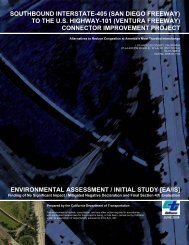Sepulveda Dam Basin Master Plan - Los Angeles District - U.S. Army
Sepulveda Dam Basin Master Plan - Los Angeles District - U.S. Army
Sepulveda Dam Basin Master Plan - Los Angeles District - U.S. Army
- No tags were found...
You also want an ePaper? Increase the reach of your titles
YUMPU automatically turns print PDFs into web optimized ePapers that Google loves.
The area adjacent to the model airplane field roughly bounded by Woodley Creek to thenorth and west, Woodley Avenue to the east, and the <strong>Los</strong> <strong>Angeles</strong> River and BurbankBoulevard to the south.A buffer zone around the <strong>Los</strong> <strong>Angeles</strong> River and its tributaries in the <strong>Basin</strong>: Bull Creek,Hayvenhurst Channel, Woodley Creek, Haskell Creek, and Encino Creek.Area located south of Burbank Blvd., west of the <strong>Dam</strong>, and north of the <strong>Los</strong> <strong>Angeles</strong>River.Lands adjacent to the <strong>Los</strong> <strong>Angeles</strong> River and its tributaries are recognized as areas for potentialrestoration activities by stakeholders and the Corps. Riparian buffers, defined here as the entiretyof aquatic, wetland, and riparian forest woodland habitat within the river can reduce runoff ratesby increasing flow complexity and travel.Recommendation for this classification as all land use classifications, to implement a nativeplanting program where feasible.Recommendations include:Restoration of upland and riparian communities would increase the overall quality of theseareas for wildlife habitat.Conduct periodic biological site surveys to monitor the presence of any rare or endangeredspecies such as the least Bell’s vireo.Dogs and other domesticated animals are not allowed, on or off trail.Prepare a management plan for long –term invasive plant eradication.Promote safety in isolated areas bya. Signs posted describing the inherent dangers of potential flooding in these areas.b. <strong>Plan</strong>ting “unfriendly” but appropriate native riverine plants such as native roses(Rosa californica) at entry points into the areas with appropriate warning signsand plant identification.c. Periodic but irregular “sweeps” by enforcement personnel to reduce “illegalactivities”, remove encampments, and direct people out of the area. Such sweepscannot be reliably predicted, but if occur frequently enough, the likelihood ofpeople immediately returning is diminished.d. Vegetation management as required includes trimming and clearing/mowing foruser safety and security.The extent and area of lands included within each proposed land use classification aredescribed, including total acreage and lands proposed for new classifications are mappedin Appendix E Map 23; andA description of Corps policy and guidance appropriate for each land use classificationhas been provided to guide appropriate designation and future development andmanagement of the lands.Land Use Classification and Resource <strong>Plan</strong> Recommendations 6-7



